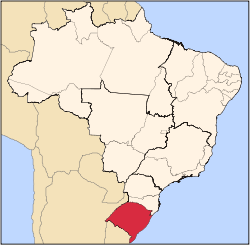Lagoa Bonita do Sul | |
|---|---|
 Location within Rio Grande do Sul | |
| Coordinates: 29°29′20″S53°00′50″W / 29.48889°S 53.01389°W | |
| Country | |
| State | Rio Grande do Sul |
| Population (2020 [1] ) | |
• Total | 2,921 |
| Time zone | UTC−3 (BRT) |
Lagoa Bonita do Sul is a municipality in the state of Rio Grande do Sul, Brazil.




